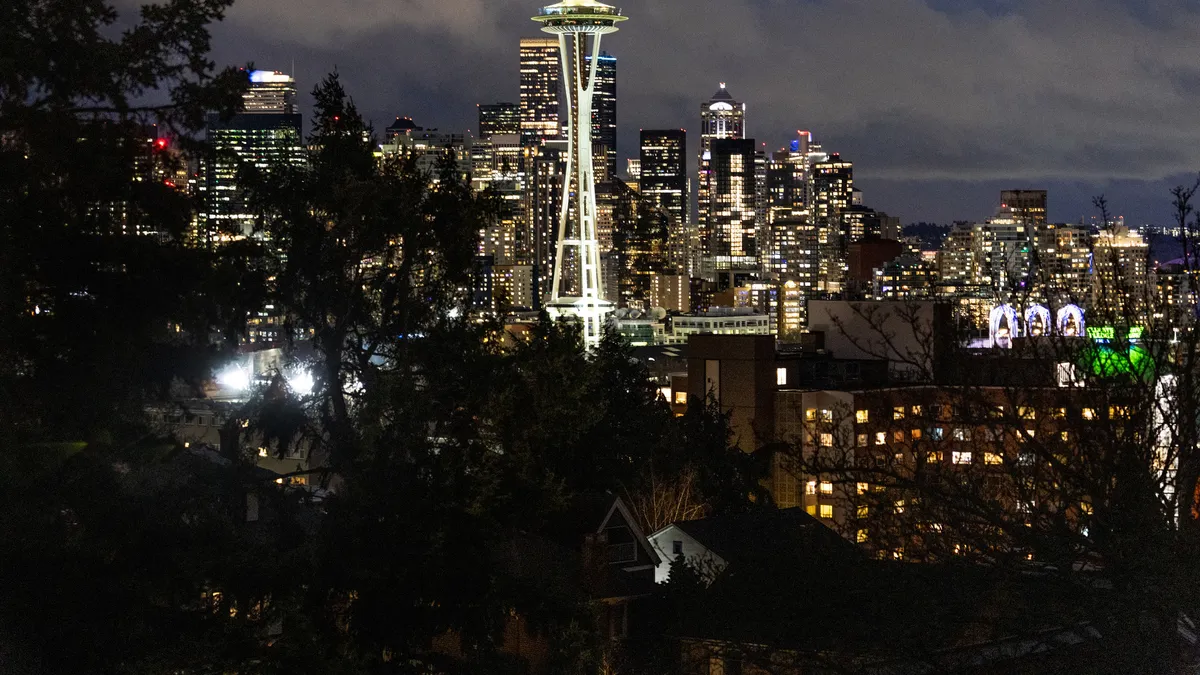Dive Brief:
- A jury awarded $150 million in damages to the families of victims in a deadly 2019 crane collapse at a Google construction project in Seattle that killed four people and injured three others.
- The jury found Northwest Tower Crane, Omega Morgan, GLY Construction and Morrow Equipment negligent in the collapse, which occurred when high winds hit the crane as it was being taken down. Contractors ignored the manufacturer's instructions for dismantling the crane by removing almost all of the tower's pins and sleeves at the same time.
- However, the negligence of GLY Construction, which leased the crane, was found not to have contributed to the deaths and injuries of the plaintiffs in the case. According to court documents, the jury assigned 45% of the blame to Northwest Tower Crane, which was responsible for setting up and dismantling the equipment; 30% to mobile crane subcontractor Omega Morgan; and 25% to Morrow Equipment, the crane owner.
Dive Insight:
Morrow Equipment did not participate in the trial and was instead included as an "empty chair" defendant, according to attorney David Beninger, lead for the consolidated plaintiffs at trial. For that reason, the net damages in the case will be reduced by 25%, to about $112 million, as plaintiffs pursue a "separate deal" with Morrow, Beninger said.
The collapse killed Alan Justad, a 71-year-old city planning official, and Sarah Wong, a 19-year-old Seattle Pacific University student, along with ironworkers Andrew Yoder, 31, and Travis Corbet, 33, who were working on the project.
Even with the 25% reduction, the jury damages dwarf the $107,200 fine levied by the Washington State Department of Labor and Industries (L&I) in the case, illustrating how accidents on construction sites can have ramifications far beyond just complying with safety rules.
"It's simple. When your work affects the public, your job is to protect the public," said Beninger. The attorney said that while Morrow Equipment and GLY Construction had taken responsibility for their actions and implemented safety changes, Omega Morgan has not.
Omega Morgan's attorney, Rodney Umberger, sent Construction Dive a statement that asserted it was responsible for a different, mobile crane at the site. It said its team didn't experience any accident or malfunction on its equipment the day the tower crane collapsed.
"Omega respects the commitment and service the jurors to this case provided, despite disagreeing with the jury’s conclusion with respect to Omega’s liability," read the firm's statement. "It appears the jury has sought to hold Omega responsible for work and services performed by other, independent contractors that Omega neither hired nor supervised."
The firm said it would continue to defend itself, including by pursuing an appeal of the jury’s decision.
Morrow Equipment declined to comment for this article. Representatives for Northwest Tower Crane and GLY Construction did not immediately return phone calls seeking comment.
However, ABC News reported that an attorney for Northwest Tower issued the following statement: "Northwest Tower Crane Service respects the verdict of the jury and thanks them for their service in this trial. Northwest Tower Crane changed its practices immediately after this tragic accident and continues to strive to make safety its top priority."
Safety response
The accident served as a wake-up call in the industry when it happened.
Washington State's Division of Occupational Safety and Health (DOSH) issued a statewide industry hazard alert emphasizing how important it is that crews follow the correct procedures when assembling and tearing down cranes.
Part of the division's directive made it clear that crane companies must follow manufacturer's instructions and that a crane section's pins and connectors should only be removed when crews are preparing that section to be lifted. L&I said that other states and some countries have used its June 2019 alert as the basis of their own hazard alerts.
In addition, after asking contractors to report when they are assembling or dismantling tower cranes, DOSH has performed spot inspections during these activities.
Removing all the pins in the way that the Seattle crews did on the day of the collapse is not unusual, Stever Frein, lead crane instructor at West Coast Training in Woodland, Washington, said at the time of the collapse.
"They use it as a time shortcut," he said, "and sometimes it doesn't work out. But it's totally against manufacturer's specifications and recommendations about how to take [cranes] apart."















